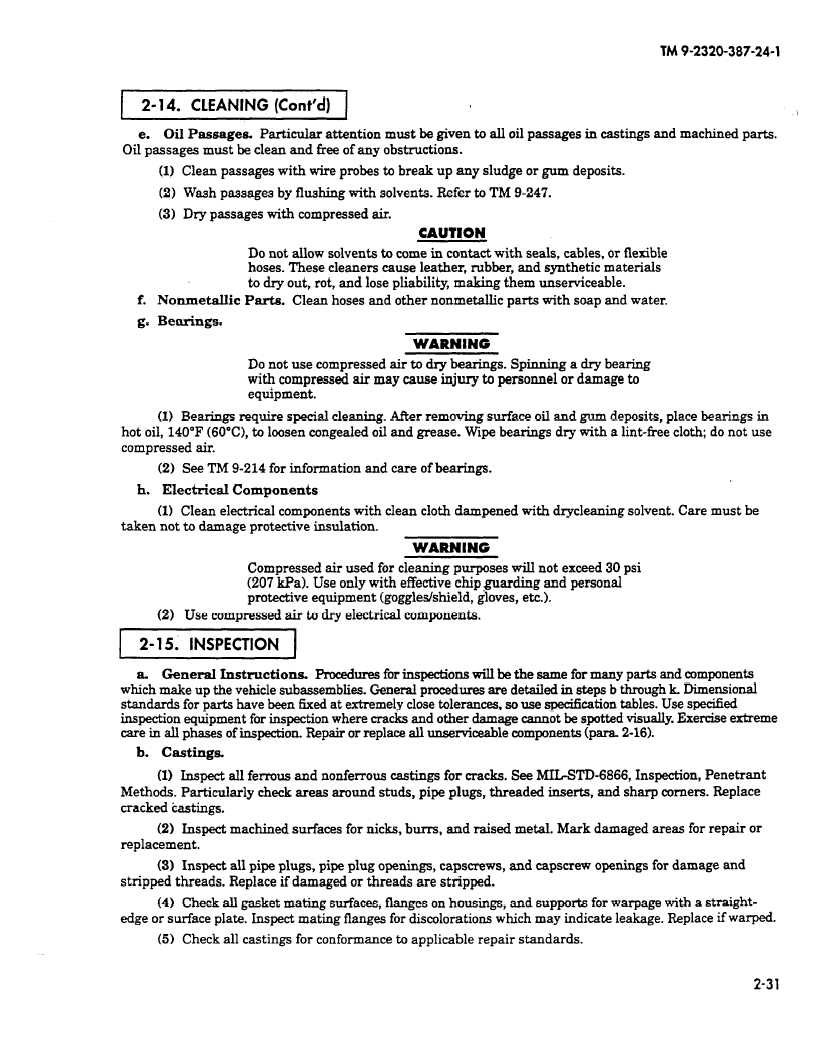TM 9-2320-387-24-l
2- 14. CLEANING (Cont’d)
\
e. Oil Passagea Particular attention must be given to all oil passages in castings and machined parts.
Oil passages must be clean and free of any obstructions.
(1) Clean passages with wire probes to break up any sludge or gum deposits.
(2) Wash passages by flushing with solvents. Refer to TM 9-247.
(3) Dry passages with compressed air.
CAUTION
Do not allow solvents to come in contact with seals, cables, or flexible
hoses. These cleaners cause leather, rubber, and synthetic materials
to dry out, rot, and lose pliability, making them unserviceable.
f. Nonmetallic Parts. Clean hoses and other nonmetallic part6 with soap and water.
g. Bearings.
WARNING
Do not use compressed air to dry bearings. Spinning a dry bearing
with compressed air may cause injury to personnel or damage to
equipment.
(1) Bearings require special cleaning. After removing surface oil and gum deposits, place bearings in
hot oil, 140°F (6O”C),
to loosen congealed oil and grease. Wipe bearings dry with a lint-free cloth; do not use
compressed air.
(2) See TM 9-214 for information and care of bearings.
h. Electrical Component6
(1) Clean electrical components with clean cloth dampened with drycleaning solvent. Care must be
taken not to damage protective insulation.
WARNING
Compressed air used for cleaning purposes will not exceed 30 psi
(207 kPa). Use only with effective chip guarding and personal
protective equipment (goggles/shield, gloves, etc.).
(2) Use compressed air to dry electrical components.
2- 15. INSPECTION
a. General Instruction& Procedure6
for inspections will be the same for many parts and components
which make up the vehicle subassemblies. General procedures are detailed in steps b through IL Dimensional
standards for parts have been 6xed at extremely close tolerances, so use specification tables. Use specified
inspection equipment for inspection where cracks and other damage cannot be spotted visually. Exercise extreme
care in all phases of inspection. Repair or replace all un6erviceable components (para. 2-16).
b. Castings.
(1) Inspect all ferrous and nonferrous castings for cracks. See MIL-STD-6866, Inspection, Penetrant
Methods. Particularly check areas around studs, pipe plugs, threaded inserts, and sharp comers. Replace
cracked &&ings.
(2) Inspect machined surfaces for nicks, burrs, and raised metal. Mark damaged areas for repair or
replacement.
(3) Inspect all pipe plugs, pipe plug openings, capscrews, and capscrew openings for damage and
stripped threads. Replace if damaged or threads are stripped.
(4) Check all gasket mating surfaces, flanges on housings, and supports for warpage with a straight-
edge or surface plate. Inspect mating flanges for discolorations which may indicate leakage. Replace if warped.
(5) Check all castings for conformance to applicable repair standards.
2-31

